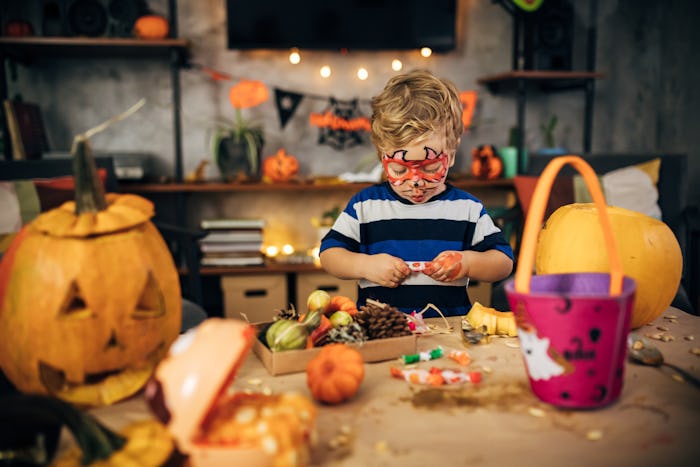Life

Do You Actually Have To Disinfect Halloween Candy Wrappers? Experts Weigh In
In previous years, the most stressful part of trick-or-treating was when overly tired and sugared-up kids either fought about who got the best candy or insisted they needed to eat way more treats than humanly possible. This year, the most stressful part of trick-or-treating is knowing that the coronavirus might be lurking behind every door. So what can you do to keep your kids safe? And is disinfecting Halloween candy wrappers necessary?
“It is very unlikely that the virus will survive on candy wrapping for a prolonged period of time,” infectious disease physician Gabriela Andujar Vazquez, M.D. tells Romper via email. “We can further decrease this risk by washing our hands before taking the candy, after taking it, and before and after eating it.” (In other words, bring the hand sanitizer and use it as often as possible.)
Dr. Syra Madad, pathogen preparedness expert and infectious disease epidemiologist, agrees, telling Romper that she "would not recommend sanitizing items you plan to consume, like candy." She also doesn't recommend dropping wrapped candy in a bowl of warm water and soap and drying it before eating. As she explains, "it goes back to basics; you can try to jump through as many loops but at the end of the day it’s hand hygiene, limiting touching surfaces and mucous membranes, wearing a mask, etc.”
She adds that for a trick-or-treater to get the virus from touching candy, someone who has the virus would have to expel respiratory droplets directly onto the candy. This means a person with active coronavirus would need to sneeze or cough directly onto the candy bowl or on their hands before filling the bowl (gross), then the child would have to touch that candy, then almost immediately touch their own mucus membranes. There’s a very low chance of this happening (though not zero, she said).
If you still feel like you want to disinfect the candy, Dr. Andujar Vazquez tells Romper that cleaning the wrapping with "regular household wipes" is fine. But, she adds, “if you routinely wash your hands before and after eating, sanitizing the candy should not be necessary.”
Just because you’re not Lysoling your candy stash (or disinfecting your pumpkin, for that matter), you should still give it a once-over before letting your kids dig in. “The same principles would apply during non-COVID-19 days; only accept candy that’s fully factory-wrapped and hasn’t been tampered with or open,” Dr. Madad says. “Avoid homemade or self-wrapped candy. It’s also good to assume unclean hands may have touched the candy prior to you or your child receiving it, so hand hygiene after touching the candy is a good idea. Clean your hand after opening the candy and before eating it.”
And remember, while the candy’s probably safe, trick-or-treating isn't risk-free. The most important thing to be aware of is how close your family is coming to other people who are not part of your bubble, especially if those people are unmasked (and no, unfortunately Halloween masks don’t count). If you opt to go door-to-door, try to remain distanced, definitely skip the apple bobbing, and try to keep the fun outside.
Experts:
Gabriela Andujar Vazquez, M.D., Infectious Disease Physician and Associate Hospital Epidemiologist at Tufts Medical Center
Syra Madad, M.D., Pathogen Preparedness Expert and Infectious Disease Epidemiologist